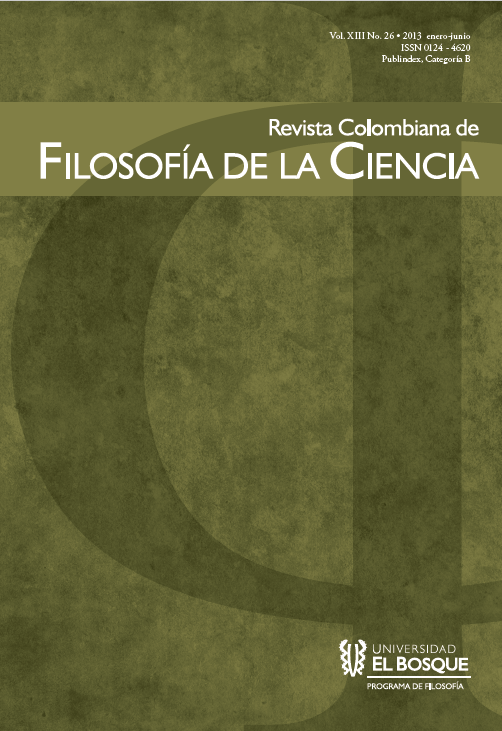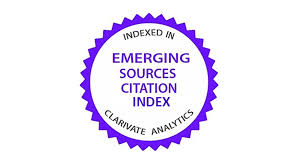La relación entre química y física: isomerismo óptico y la paradoja de Hund
DOI:
https://doi.org/10.18270/rcfc.v13i26.1649Resumen
En el presente trabajo abordamos el problema de la relación entre química y física focalizándonos
en la cuestión del isomerismo óptico y la llamada ‘paradoja de Hund’, que
apunta a la dificultad de dar cuenta de la quiralidad mediante la mecánica cuántica. En
particular, presentamos la solución a la paradoja propuesta desde la teoría de la decoherencia.
El objetivo del trabajo consiste en cuestionar esta solución a la luz de una
interpretación precisa del concepto de decoherencia. Sobre esta base argumentamos
que una respuesta satisfactoria a la paradoja de Hund sólo puede brindarse desde una
adecuada interpretación de la mecánica cuántica, que logre sortear los desafíos conceptuales
de la teoría.
Descargas
Referencias bibliográficas
Adler, S. “Why decoherence has not solved the measurement problem: A
response to P. W. Anderson”. Studies in History and Philosophy of Modern
Physics 34 (2003): 135-142.
Ardenghi, J. S., Fortin, S. & Lombardi, O. “The conceptual meaning of
reduced states: decoherence and interpretation”. 14th Congress of Logic,
Methodology and Philosophy of Science. Nancy, 2011.
Bacciagaluppi, G. “The role of decoherence in quantum mechanics”. The
Stanford Encyclopedia of Philosophy. Ed. E. N. Zalta. 2008.
stanford.edu/ archives/fall2008/entries/qm-decoherence/>.
Bacciagaluppi, G. & Hemmo, M. “Making sense of approximate decoherence”.
Proceedings of the Philosophy of Science Association 1 (1994): 345-354.
—.. “Modal interpretations, decoherence and measurements”. Studies in
History and Philosophy of Modern Physics 27 (1996): 239-277.
Bader, R. Atoms in Molecules: A Quantum Theory. Oxford: Oxford University
Press, 1994.
Ballentine, L. Quantum Mechanics: A Modern Development. Singapore: World
Scientific, 1998.
Berlin, Y. A., Burin, A. L. & Goldanskii, V. V. “The Hund paradox and
stabilization of molecular chiral states”. Zeitschrift für Physik D 37 (1996):
-339.
Bub, J. Interpreting the Quantum World. Cambridge: Cambridge University
Press, 1997.
D’Espagnat, B. “An elementary note about mixtures”. Preludes in Theoretical
Physics. Eds. A. De-Shalit, H. Feshbach & L. van Hove. Amsterdam:
North-Holland, 1966.
D’Espagnat, B. Conceptual Foundations of Quantum Mechanics. Reading,
MA: Benjamin, 1976.
Dirac, P. A. M. “Quantum mechanics of many-electron systems”. Proceedings
of the Royal Society of London A 123 (1929): 714-33.
Elby, A. “The ‘decoherence’ approach to the measurement problem in
quantum mechanics”. Proceedings of the 1994 Biennial Meeting of the Philosophy
of Science Association 1 (1994): 355-365.
Harris, R. A. & Stodolsky, L. “Time dependence of optical activity”. The
Journal of Chemical Physics, 74 (1981): 2145-2155.
Healey, R. A. “Dissipating the quantum measurement problem”. Topoi 14
(1995): 55-65.
Heisenberg, W. “The physical content of quantum kinematics and mechanics”.
Quantum Theory and Measurement. Eds. J. A. Wheeler & W. H.
Zurek. Princeton: Princeton University Press, 1983. Trad. de “Über den
anschaulichen Inhalt der quantentheoretischer Kinematic und Mechanik”.
Zeitschrift für Physik 43 (1927): 172-198.
Hendry, R. F. “The physicists, the chemists, and the pragmatics of explanation”.
Philosophy of Science 71 (2004): 1048-59.
—. “Two conceptions of the chemical bond”. Philosophy of Science 75 (2008):
-920.
—. “Ontological reduction and molecular structure”. Studies in History and
Philosophy of Modern Physics 41 (2010): 183-191.
Hettema, H. “Explanation and theory foundation in quantum chemistry”.
Foundatios of Chemistry 11 (2009): 145-174.
—.Reducing Chemistry to Physics. Limits, Models, Consecuences. Groningen:
University of Groningen, 2012.
Hund. F. “Zur Deutung der Molekelspektren. III”. Zeitschrift für Physik, 43,
(1927) 805-826.
Joos, E. “Elements of environmental decoherence”. Decoherence: Theoretical,
Experimental, and Conceptual Problems, Lecture Notes in Physics, Vol. 538.
Eds. P. Blanchard, D. Giulini, E. Joos, C. Kiefer & I. O. Stamatescu.
Heidelberg-Berlin: Springer, (2000).
Landau, L. D. & Lifshitz, E. M. Mecánica Cuántica No-Relativista. Barcelona:
Reverté, 1972.
Leggett, A. J. “Reflections on the quantum measurement paradox”. Quantum
Implications. Eds. B. J. Hiley & F. D. Peat. Londres: Routledge and Kegan
Paul, 1987.
Lombardi, O & Castagnino, M. “A modal-Hamiltonian interpretation of
quantum mechanics”. Studies in History and Philosophy of Modern Physics
(2008a): 380-443.
—. “The role of the Hamiltonian in the interpretation of quantum mechanics”.
Journal of Physics. Conferences Series. 2008b, # 012014. Institute of
Physics and IOP Publishing Limited 28.
—. “Matters are not so clear on the physical side”. Foundations of Chemistry
(2010): 159-166.
Lombardi, O., Fortin, S., Castagnino M. & Ardenghi, J. S. “Compatibility
between environment-induced decoherence and the modal-Hamiltonian
interpretation of quantum mechanics”. Philosophy of Science 78 (2011):
-1036.
Lombardi, O. & Labarca, M. “The ontological autonomy of the chemical
world”. Foundations of Chemistry 7 (2005): 125-148.
—. “The ontological autonomy of the chemical world: A response to
Needham”. Foundations of Chemistry 8 (2006): 81-92.
Nagel, E. The Structure of Science. New York: Harcourt, Brace & World, 1961.
Paz, J. P. & Zurek, W. H. “Environment-induced decoherence and the transition
from quantum to classical”. Fundamentals of Quantum Information.
Lecture Notes in Physics, Vol. 587. Ed. D. Heiss. Heidelberg-Berlin: Springer,
(los números de página está tomados de arXiv:quant-ph/0010011).
Primas, H. Chemistry, Quantum Mechanics and Reductionism. Berlin: Springer,
Scerri, E. R. “Realism, reduction and the ‘intermediate position”. Of Minds
and Molecules. New Philosophical Perspectives on Chemistry. Eds. N. Bhushan
& S. Rosenfeld. New York: Oxford University Press, 2000.
—. “Just how ab initio is ab initio quantum chemistry?”. Foundations of
Chemistry 6 (2004): 93-116.
—. “Normative and descriptive philosophy of science and the role of
chemistry”. Philosophy of Chemistry: Synthesis of a New Discipline. Eds.
D. Baird, E. Scerri & L. McIntyre. Dordrecht: Springer, 2006. 119-128.
Boston Studies in the Philosophy of Science 242.
—. “Editorial 37”. Foundations of Chemistry 13 (2011): 1-7.
Scerri, E. R. & McIntyre, L. “The case for the philosophy of chemistry”.
Synthese 111 (1997): 213-232.
Schlosshauer, M. Decoherence and the Quantum-to-Classical Transition. Berlin:
Springer, 2007.
Sutcliffe, B. T. & Wolley, R. G. “A comment on Editorial 37”. Foundations of
Chemistry, 13 (2011): 93-95.
—.. “Atoms and molecules in classical chemistry and quantum mechanics”.
Handbook of Philosophy of Science. Vol. 6, Philosophy of Chemistry. Eds. R.
F. Hendry & A Woody. Oxford: Elsevier, 2012.
Szabo, A & Ostlund, N. S. Modern Quantum Chemistry: Introduction to
Advanced Electronic Structure Theory. Mineola, NY: Dover Publications,
Van Brakel, J. Philosophy of Chemistry. Between the Manifest and the Scientific
Image. Leuven: Leuven University Press, 2000.
Vemulapalli, G. K. & Byerly, H. “Remnants of reductionism”. Foundations of
Chemistry 1 (1999): 17-41.
Wolley, R. G. “Quantum theory and molecular structure”. Advances in Physics
(1976): 27-52.
—. “Must a molecule have a shape?”. Journal of the American Chemical Society
(1978): 1073-1078.
—. “Is there a quantum definition of a molecule?”. Journal of Mathematical
Chemistry 23 (1998): 3-12.
Zurek, W. H. “Pointer basis of quantum apparatus: into what mixture does
the wave packet collapse?”. Physical Review D 24 (1981): 1516-1525.
—. “Environment-induced superselection rules”. Physical Review D 26 (1982):
-1880.
—. “Decoherence and the transition from quantum to classical”. Physics Today
(1991): 36-44.
—. “Preferred states, predictability, classicality and the environment-induced
decoherence”. Progress of Theoretical Physics 89 (1993): 281-312.
—. “Decoherence, einselection, and the quantum origins of the classical”.
Reviews of Modern Physics 75 (2003): 715-776.
Descargas
Publicado
Cómo citar
Número
Sección

| Estadísticas de artículo | |
|---|---|
| Vistas de resúmenes | |
| Vistas de PDF | |
| Descargas de PDF | |
| Vistas de HTML | |
| Otras vistas | |











